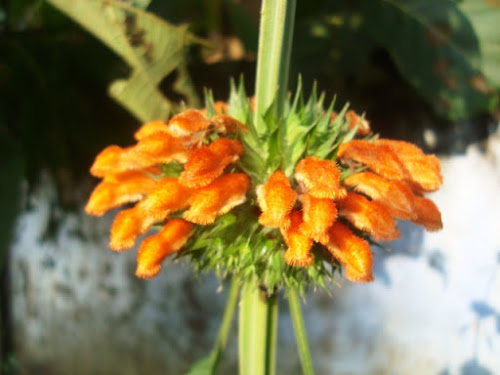 |
| lal guma |
Names of Lions ear in other language
Lion's Ear, Annual lion's
ear or Christmas candlestick is called Bara
guma, Robla and Lal guma in Hindi, Bhut Bhairab, Dare Dhompo, Hejurcheri in Bengali, Deepmal in Marathi , Hanumantabira,
Magabura, Mulagolimedi,
Rana Chettu in Telugu, Goa Gadde, Kaaduthumbe, Devvadumbe, Ranabheri, Deepa Shoole in Kannada, Ranaperi in
tamil, Granthi, Granthika, Granthila, Gramyakunkuma, Grihadvaraparshve, Grishti, Granthiparna, Granthiparni in
Sanskrit. In my mother tongue Odia, we call it Barchha which means spear. The shape of the plant tells us about
its name why it is so. But the English term i.e. Lion’s ear is also given
because the small orange petals look like tiny ears.
Its Botanical name is Leonotis nepetifolia.
It is a native of tropical
Africa but is now naturalized worldwide. We can find this plant now anywhere in
India.
Lion's Ear is a tall, erect
and slim plant which can grow up to 7 to 8 ft tall. The stems are smooth but
have coarsely ragged margins, triangular in shape and around 2-5 in length. The
flowers are commonly orange. The leaves are serrated and can grow up to 4
inches in breadth. As the stems extend, new flowers continue to bloom above the
older petals. The flowering time is November and December. You can propagate it
from seeds.
The plant has mild
psychoactive, narcotic properties. The flowers have potent medicinal properties
and is used as a calming tea. It has also anti-asthmatic, anti-diarrhea
properties and is a tonic for heart; which assuages palpitations, irregular
heartbeats, tachycardia and it is many times used for heart disorders arising
out of anxiety and stress. These plants are used to regulate menstruation.
 |
| Rana Chettu |
 |
| Mulagolimedi |